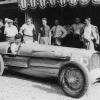i think you're selling the designers a bit short there!
Those high wings would have had less of an effect at Monaco, as they would have added a lower percentage of vertical load to the tyres, but certainly not useless.
Its the opposite tradeoff to Monza (where we came in). If the logic used there was that the extra downforce was of less importance than the added drag, then at Monaco it was (and always has been ever since) that you add as much downforce as you can achieve and dont worry about the drag.
And that almost always is the fastest way around there.
So if the Monza balance favoured removing wings, Monaco favoured leaving them on.
An interesting aside to the relative importance of drag there is that it was probably the only circuit used in 1969 where a flat plate might have worked tolerably well, and as well as some of the wings used from Zandvoort onwards, although still not as effective as the strutted wings, low average speed not withstanding.(except perhaps Montjuich Parkor St Jovite, although both race averages were between 15mph -20mph faster than Hills approx 80mph at Monaco?).
I think thats what we saw, and Stewarts remarks about the grip coming in on a street circuit are as relevant today as they were in 1969.
If the ban had comeone one race later at Zandvoort i think it would have been a serious Teddy out of Pram situation.
(And whilst appreciating that BRM were by then running the v12, didnt the H16 have provision for a longitudinal driveshaft in the crankcase, incase 4WD was indeed required with 3 litres?)
Peter




















